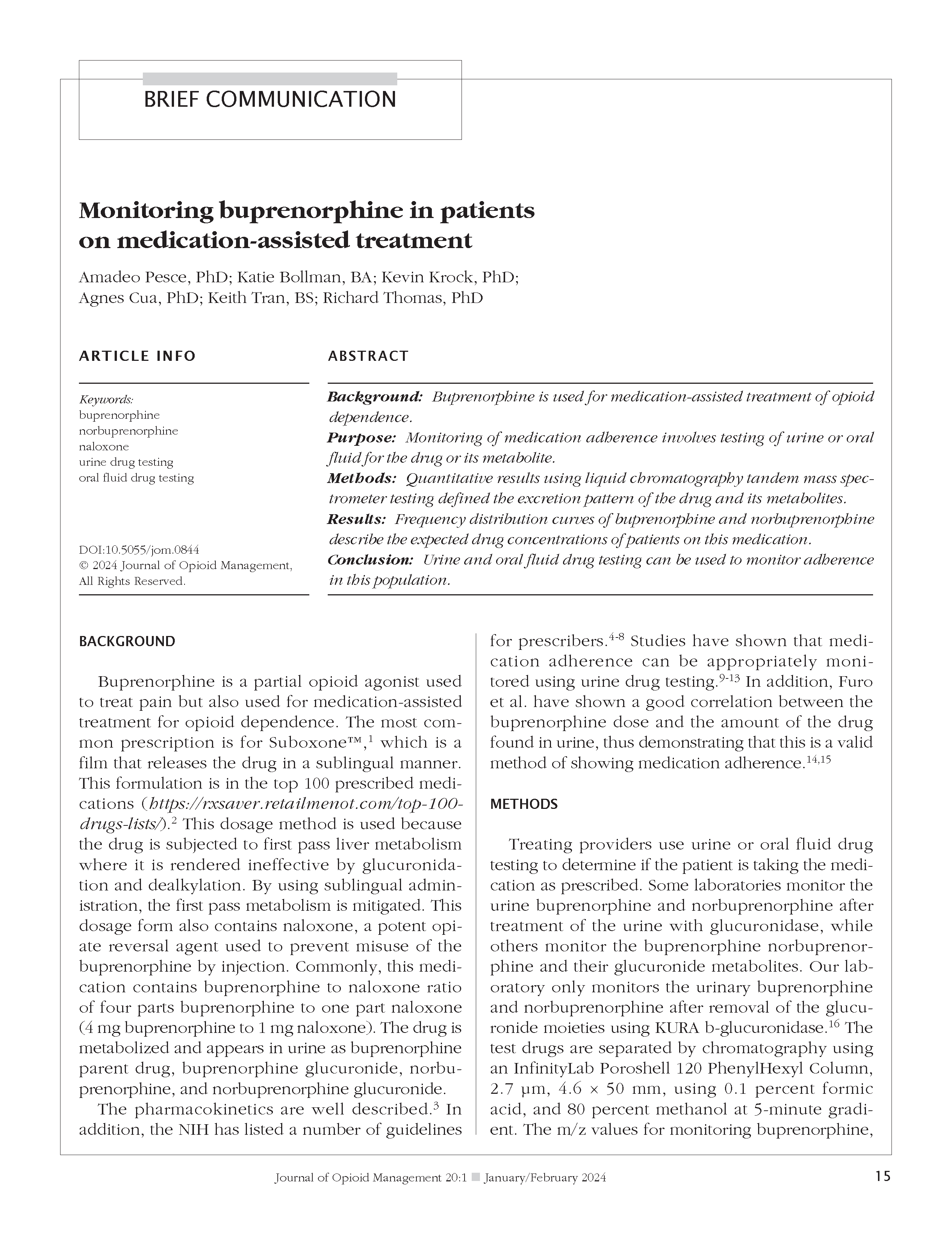Monitoring buprenorphine in patients on medication-assisted treatment
DOI:
https://doi.org/10.5055/jom.0844Keywords:
buprenorphine, norbuprenorphine, naloxone, urine drug testing, oral fluid drug testingAbstract
Background: Buprenorphine is used for medication-assisted treatment of opioid dependence.
Purpose: Monitoring of medication adherence involves testing of urine or oral fluid for the drug or its metabolite.
Methods: Quantitative results using liquid chromatography tandem mass spectrometer testing defined the excretion pattern of the drug and its metabolites.
Results: Frequency distribution curves of buprenorphine and norbuprenorphine describe the expected drug concentrations of patients on this medication.
Conclusion: Urine and oral fluid drug testing can be used to monitor adherence in this population.
References
Suboxone Uses Dosage Side Effects and Warnings Drugs: Available at https://www.drugs.com/suboxone.html.com. Accessed January 12, 2024.
RxSaver Editors Top 100 most commonly searched medications: Available at https://rxsaver.retailmenot.com/top-100-drugslists/. Accessed January 12, 2024.
Elkader A, Sproule B: Buprenorphine: Clinical pharmacokinetics in the treatment of opioid dependence. Clin Pharmacokinet. 2005; 44(7): 661-680. DOI: 10.2165/00003088-200544070-00001. DOI: https://doi.org/10.2165/00003088-200544070-00001
Pergolizzi J, Böger RH, Budd K, et al.: Sacerdote opioids and the management of chronic severe pain in the elderly: Consensus statement of an international expert panel with focus on the six clinically most often used World Health Organization step iii opioids (buprenorphine, fentanyl, hydromorphone, methadone, morphine, oxycodone). Pain Pract. 2008; 8(4): 287-313. DOI: 10.1111/j.1533-2500.2008.00204.x. DOI: https://doi.org/10.1111/j.1533-2500.2008.00204.x
Kumar R, Viswanath O, Saadabadi A: StatPearls [Internet]. Treasure Island, FL: StatPearls Publishing, 2023. Available at https://www.ncbi.nlm.nih.gov/books/NBK459126/. Accessed January 12, 2024.
Preuss CV, Kalava A, King KC: Prescription of controlled substances: Benefits and risks. In StatPearls [Internet]. Treasure Island, FL: StatPearls Publishing, 2023. Available at https://nmhs.cloud-cme.com/assets/nmhs/Presentations/1281/1281.pdf. Accessed January 12, 2024.
Horn DB, Vu L, Porter BR, et al.: Responsible controlled substance and opioid prescribing. In StatPearls [Internet]. Treasure Island, FL: StatPearls Publishing, 2023.
Dydyk AM, Sizemore DC, Haddad LM, et al.: NP safe prescribing of controlled substances while avoiding drug diversion. In StatPearls [Internet]. Treasure Island, FL: StatPearls Publishing, 2023.
Cohen AN, Collins G, Nucifora FC, Jr, et al.: Clinical consensus recommendations for urine testing of adherence to antipsychotics among people with serious mental illness. Psychiatric Serv. 2018; 69: 345-348. DOI: 10.1176/appi.ps.201700082. DOI: https://doi.org/10.1176/appi.ps.201700082
Kavanagh K, Tallian K, Sepulveda JA, et al.: Do buprenorphine doses and ratios matter in medication assisted treatment adherence? Ment Health Clin. 2022; 12(4): 241-246. DOI: 10.9740/mhc.2022.08.241. DOI: https://doi.org/10.9740/mhc.2022.08.241
Kovar L, Schräpel C, Selzer D, et al.: Physiologically-based pharmacokinetic (PBPK) modeling of buprenorphine in adults, children and preterm neonates. Pharmaceutics. 2020; 12: 578. DOI: 10.3390/pharmaceutics12060578. DOI: https://doi.org/10.3390/pharmaceutics12060578
Warrington JS, Warrington GS, Francis-Fath S, et al.: Urinary buprenorphine, norbuprenorphine and naloxone concentrations and ratios: Review and potential clinical implications. Addict Med. 2020; 14: e344-e349. DOI: 10.1097/ADM.0000000000000676. DOI: https://doi.org/10.1097/ADM.0000000000000676
Anderson PL: Commentary: What can urine tell us about medication adherence? EClinicalMedicine. 2018; 22-28. DOI: 10.1016/j.eclinm.2018.08.004. DOI: https://doi.org/10.1016/j.eclinm.2018.09.003
Furo H, Wiegand T, Rani M, et al.: Association between buprenorphine dose and the urine “norbuprenorphine” to “creatinine” ratio: Revised. Subst Abuse. 2023; 17: 11782218231153748. DOI: 10.1177/11782218231153748. DOI: https://doi.org/10.1177/11782218231153748
Furo H, Schwartz DG, Sullivan RW, et al.: Buprenorphine dosage and urine quantitative buprenorphine, norbuprenorphine, and creatinine levels in an office-based opioid treatment program substance abuse: Research and treatment. Subst Abuse. 2021; 15: 1-9.
Krock K, Pesce A, Ritz D, et al.: Lower cutoff for LC-MS/MS urine drug testing indicates better patient compliance. Pain Phys. 2017; 7: E1107-E1113. DOI: https://doi.org/10.36076/ppj/2017.7.E1107
Krock K, Nickley J, Tran K, et al.: Correlation of fentanyl positive drug screens with other medications in patients from pain. Rehabil Behav Prog Ann Clin Lab Sci. 2020; 50(2): 55-60.
Pesce A, West C, West R, et al.: Reference intervals: A novel approach to detect drug abuse in a pain patient population. J Opioid Manag. 2010; 6: 341-350. DOI: https://doi.org/10.5055/jom.2010.0031
Pesce A, West C, West R, et al.: Determination of medication cutoff values in a pain patient population. J Opioid Manag. 2011; 7(2): 117-122. DOI: https://doi.org/10.5055/jom.2011.0054
West R, Pesce A, Crews B, et al.: Determination of illicit drug cutoff values in a pain patient population. Clin Chim Acta. 2011; 412: 1589-1593. DOI: https://doi.org/10.1016/j.cca.2011.05.004
Nagpal G, Heiman H, Haymond S: Interpretation of urine drug screens metabolites and impurities. JAMA Diagnostic Test Interpretation. Available at https://www.oregonpainguidance.org/wp-content/uploads/2018/02/Interpretation-of-UDSJAMA-2017.pdf?x91687. Accessed January 12, 2024.
Smiley S, Pesce A, Krock K, et al.: A comparison of urine and oral fluid drug testing. J Clin Toxicol. 2019; 9: 414. DOI: 10.4172/2161-0495.1000414.
Cua A, Krock K, Thomas R, et al.: Estimates of drug metabolism using drug excretion concentrations. Ann Clin Lab Sci. 2023; 53: 460-468.
Cua A, Krock K, Thomas R, et al.: Letter to Editor: Observations of deception in urine drug testing annals of clinical & laboratory science. Ann Clin Lab Sci. 2023; 53(4): 671-672.
Butrans Patch: Available at https://www.drugs.com/pro/butrans-patch.html. Accessed January 12, 2024. DOI: 10.1177/11782218211061749. DOI: https://doi.org/10.1177/11782218211061749

Downloads
Published
How to Cite
Issue
Section
License
Copyright 2005-2025, Weston Medical Publishing, LLC and Journal of Opioid Management. All Rights Reserved.










